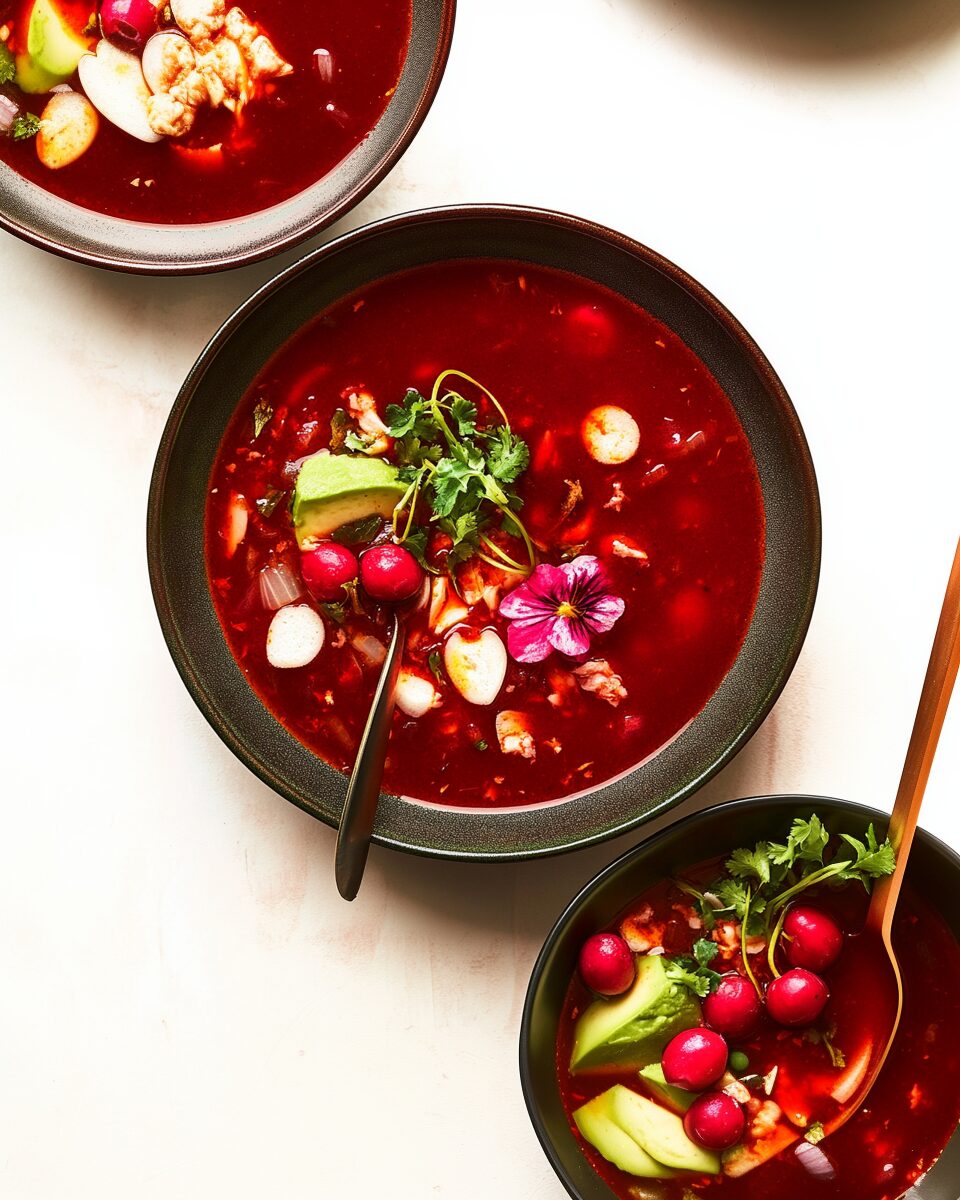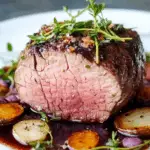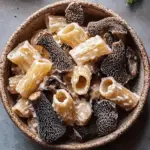Pozole Rojo is a traditional Mexican stew celebrated for its rich, flavorful broth and hearty ingredients. The name “pozole” translates to “hominy,” referring to the large, puffy corn kernels that form the base of this dish. The “rojo” variant is distinguished by its vibrant red broth, achieved by simmering pork and hominy in a blend of dried red chiles. This comforting dish is often enjoyed during festive occasions and family gatherings.
Ingredients
- 2 pounds boneless pork shoulder, cut into large chunks
- 1 pound hominy, drained and rinsed (canned or dried)
- 5 dried guajillo chiles, stems and seeds removed
- 4 dried ancho chiles, stems and seeds removed
- 2 dried chile de árbol chiles, stems and seeds removed (optional, for added heat)
- 1 medium onion, coarsely chopped
- 4 cloves garlic, peeled
- 6 cups chicken broth
- 1 teaspoon ground cumin
- Salt and freshly ground black pepper, to taste
- Toppings (optional): shredded lettuce or cabbage, sliced radishes, chopped onion, dried oregano, lime wedges, and crushed red pepper
Directions
- Prepare the Chiles: In a dry skillet over medium heat, toast the guajillo, ancho, and chile de árbol chiles for about 30 seconds per side until fragrant. Be careful not to burn them.
- Soak the Chiles: Place the toasted chiles in a bowl and cover with hot water. Let them soak for about 20 minutes until softened.
- Make the Chile Sauce: Drain the soaked chiles and transfer them to a blender. Add the chopped onion, garlic, and a cup of chicken broth. Blend until smooth.
- Cook the Pork: In a large pot or Dutch oven, combine the pork shoulder chunks, remaining chicken broth, and the chile sauce. Bring to a boil over medium-high heat.
- Simmer: Reduce the heat to low, cover, and let the mixture simmer for about 1.5 to 2 hours, or until the pork is tender.
- Add Hominy: Stir in the hominy and ground cumin. Continue to simmer for an additional 30 minutes to allow flavors to meld.
- Season: Taste and adjust seasoning with salt and pepper as needed.
- Serve: Ladle the pozole into bowls and garnish with desired toppings.
Nutritional Facts
Per serving (approximately 1.5 cups):
- Calories: Approximately 476 kcal
- Protein: 19 grams
- Fat: 10 grams
- Saturated Fat: 3.5 grams
- Carbohydrates: 12 grams
- Fiber: 0.7 grams
- Sugars: 0.7 grams
- Cholesterol: 32.4 milligrams
- Sodium: 270.4 milligrams
- Vitamin D: 1% of the Daily Value
- Calcium: 1% of the Daily Value
- Iron: 14% of the Daily Value
- Potassium: 3% of the Daily Value
The Origins and Cultural Significance of Pozole
Pozole, as we know it today, has deep historical roots that trace back to ancient Mexico. The dish was originally prepared by indigenous civilizations, particularly the Aztecs, as part of their religious ceremonies. The use of hominy, which is made by soaking corn in a mixture of alkali to remove the hulls, was a vital part of their diet and held great cultural importance. Hominy was considered a sacred food, often associated with the worship of gods and fertility.
In Aztec culture, pozole was made with human sacrifice in mind, as the meat used in the dish was sometimes believed to be symbolic of a person sacrificed to the gods. This practice, while brutal and rooted in ancient beliefs, is part of the historical narrative of how pozole evolved over time. After the Spanish conquest, the practice of human sacrifice was stopped, but the dish continued to be enjoyed, albeit with more conventional ingredients such as pork, chicken, or beef.
Over the centuries, pozole became a dish enjoyed by the masses, no longer reserved for ceremonial purposes. As the dish spread throughout Mexico, regional variations began to emerge. Different areas of Mexico have their own spin on the dish, with the red version (pozole rojo) being one of the most popular. The red broth is achieved by using dried chiles like guajillo, ancho, and chile de árbol, which impart a smoky, spicy, and slightly sweet flavor to the dish. Pozole Rojo holds significant cultural value in Mexico and beyond. It is often served at family gatherings, festivals, and celebrations, particularly during the Christmas season, New Year’s Eve, and Mexican Independence Day. The dish represents togetherness and family, as it is typically prepared in large pots to serve a crowd. Sharing a bowl of pozole with loved ones is considered an expression of hospitality and generosity in Mexican culture.
The Ingredients: Key Components of Pozole Rojo
Pozole Rojo owes its distinct flavor and character to a combination of several key ingredients. At its core, pozole is made with three primary components: hominy, meat (usually pork), and a flavorful red chile sauce. These ingredients are complemented by a variety of seasonings and toppings that enhance the overall taste and texture of the dish.
-
Hominy: The star ingredient of pozole, hominy provides a chewy and hearty texture that forms the foundation of the dish. The corn kernels are treated with lime or an alkali solution, a process known as nixtamalization, which removes the hulls and softens the kernels. This process also makes the corn more nutritious and digestible. Hominy adds a subtle sweetness to the pozole, balancing the richness of the meat and the heat of the chiles.
-
Pork: The meat used in pozole is typically pork, often in the form of a pork shoulder or pork loin. Pork is a rich, flavorful meat that becomes incredibly tender when simmered for several hours in the broth. The slow cooking process infuses the pork with the spices and flavors of the broth, making it melt-in-your-mouth tender. In some variations, pozole may also be made with chicken, beef, or a combination of meats, but pork is the most common and traditional choice.
-
Red Chile Sauce: The vibrant red color and distinctive flavor of pozole rojo come from a blend of dried red chiles, such as guajillo, ancho, and chile de árbol. These chiles are toasted, rehydrated, and blended into a smooth sauce that is incorporated into the broth. The chiles provide a deep, smoky flavor with varying degrees of heat depending on the type of chile used. The addition of garlic, onion, and spices like cumin enhances the sauce and contributes to the overall richness of the dish.
-
Seasonings and Toppings: While the base of pozole is rich and savory, it is often garnished with a variety of fresh toppings. Common toppings include shredded lettuce or cabbage, sliced radishes, chopped onions, lime wedges, and dried oregano. These toppings add crunch, brightness, and freshness to the dish, balancing the rich and hearty broth. The toppings are typically added by the individual diner, allowing for personalization of the dish.
Cooking Pozole Rojo: A Step-by-Step Guide
The process of making Pozole Rojo is not overly complicated, but it does require patience and time to ensure the flavors meld together perfectly. The key to a great pozole is in the slow cooking of the pork and the careful preparation of the chile sauce. Below is a general overview of the cooking process:
-
Preparing the Chiles: Begin by toasting the dried chiles in a dry skillet over medium heat for a few seconds on each side, being careful not to burn them. This step releases the essential oils in the chiles and enhances their flavor. Once toasted, the chiles are soaked in hot water for 20-30 minutes until they become soft and pliable.
-
Making the Chile Sauce: After soaking, the chiles are blended with garlic, onion, and a bit of chicken broth to create a smooth, flavorful sauce. This sauce forms the base of the pozole rojo’s broth, adding depth and complexity to the dish.
-
Cooking the Pork: The pork shoulder or pork loin is simmered with the chile sauce and chicken broth in a large pot. The pork is cooked slowly over low heat for several hours, allowing the flavors to meld and the pork to become tender and juicy.
-
Adding the Hominy: Once the pork is tender, the hominy is added to the pot and cooked for an additional 30-60 minutes. This allows the hominy to absorb the flavors of the broth and become soft and chewy.
-
Seasoning the Pozole: The pozole is then seasoned with salt, pepper, and any additional spices to taste. Some recipes may call for a dash of cumin, oregano, or even a touch of lime juice to brighten the flavors.
-
Serving the Pozole: Pozole is traditionally served with a variety of toppings, which can be added according to personal preference. The toppings typically include shredded lettuce or cabbage, sliced radishes, chopped onions, oregano, lime wedges, and a sprinkle of crushed red pepper for added heat.
The Versatility of Pozole Rojo
Pozole Rojo is a versatile dish that can be adapted to suit various tastes and dietary preferences. While pork is the traditional choice for the meat, other proteins such as chicken, beef, or even vegetarian options can be used. In fact, some versions of pozole substitute the pork with mushrooms or other plant-based proteins, making the dish accessible to vegetarians and vegans.
In addition to the choice of meat, the level of spiciness can be adjusted by varying the types and amounts of dried chiles used in the sauce. For those who prefer a milder pozole, the number of chile de árbol chiles can be reduced or omitted entirely, while those who enjoy heat can add extra chiles for a spicier broth.
Conclusion
Pozole Rojo is a dish that embodies the heart and soul of Mexican cuisine. Its deep, rich flavors and comforting texture make it a favorite for special occasions and everyday meals alike. With its long history and cultural significance, pozole remains an integral part of Mexican culinary tradition.






